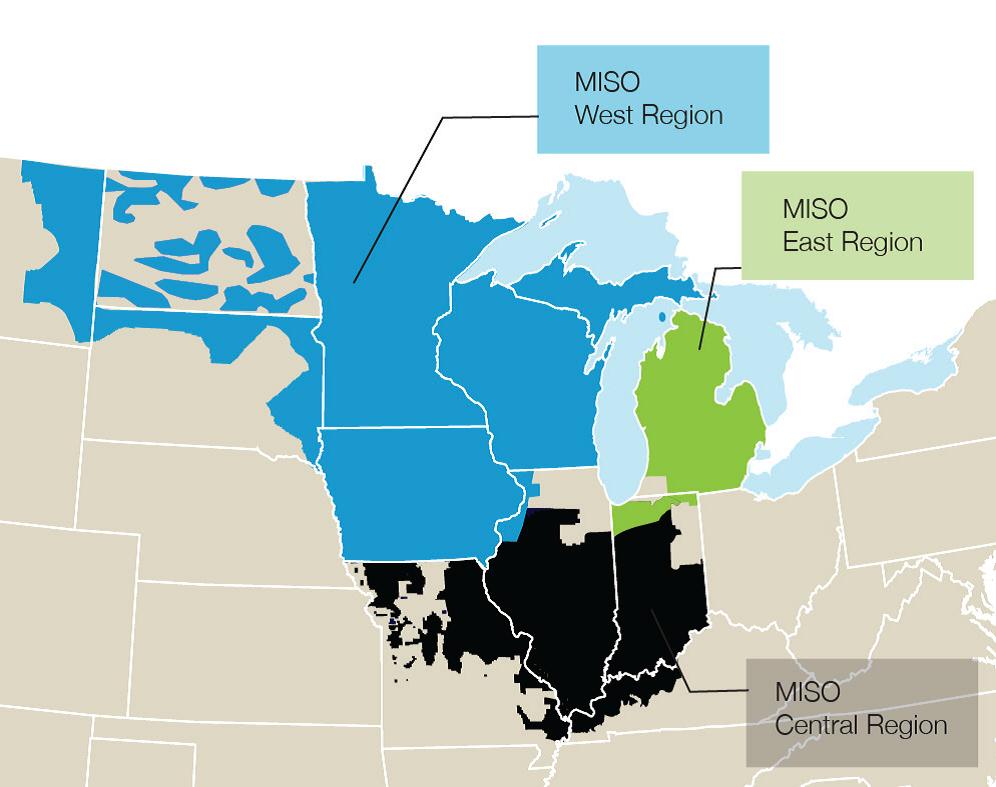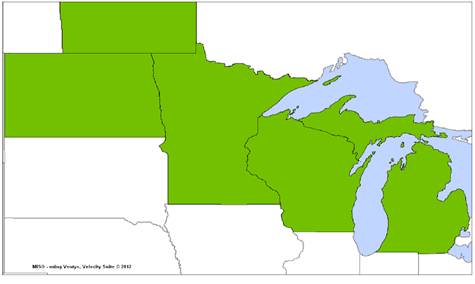Regional planning
ATC is involved in various planning efforts that address regional, inter-regional and Eastern Interconnection-wide needs that could impact our transmission system. Proposed legislation continues to evolve on Capitol Hill for renewable energy development and green-house gas emission reductions, as new legislation is developed and reviewed ATC continues to undertake internal analyses and participate in regional studies to anticipate the future demands on the transmission.
Eastern Interconnection Planning Collaborative (EIPC)
ATC is among the NERC-registered Planning Authorities in the Eastern Interconnection that form “Eastern Interconnection Planning Collaborative”. The EIPC group consists of 25 Planning Authorities. In 2010, the DOE granted an award for $16 million to the group to develop transmission expansion options for the Eastern Interconnection under different scenarios. More detailed information on the project can be found at http://www.eipconline.com .
Subsequent to the Phase 2 effort, the EIPC organization has agreed to undertake and fund a continuing effort on Eastern interconnection-wide transmission planning. This effort is separate from the DOE work and involves “rolling up” existing transmission plans from across the interconnection, looking for any areas that might benefit from more strategic transmission expansions, and performing reliability analysis for scenarios developed with stakeholder input. This is a two-year effort with the roll up work and scenario definition in 2013 and additional reliability analysis in 2014.
Regional Transmission Assessments
ATC is a member of two regional reliability organizations, the Midwest Reliability Organization (MRO) and the ReliabilityFirst Corporation (RFC). ATC participates in regional transmission assessments conducted by the MRO Transmission Assessment Subcommittee (TAS), and the RFC Transmission Performance Subcommittee (TPS). ATC also participates in the Coordinated Seasonal Assessments (CSA) conducted by MISO.
MISO Market Constraints
There are three Narrow Constrained Areas (NCAs) identified in the MISO footprint and two of them are associated with ATC. An NCA is defined as “An electrical area that has been identified by the Independent Market Monitor (IMM) that is defined by one or more Binding Transmission Constraints that are expected to be binding for at least five hundred (500) hours during a given year within which one or more suppliers are pivotal”. The two NCAs associated with ATC are Wisconsin and Upper Michigan System (WUMS) and Northern WUMS. Congestion in WUMS declined in 2010 compared to prior years, in part due to the addition and enhancement of key transmission facilities, such as the Paddock-Rockdale line placed in service in 2010, as well as new generation additions. The congestion is now often from north to south from WUMS to Com Ed. However, congestion remained above 500 hours. Although there have been a number of transmission projects in WUMS, MISO’s Independent Market Monitor (IMM) still expects that the constraints that define the WUMS NCA to surpass the 500-hour criteria during the next 12 months.
Generation Deliverability
MISO uses an aggregate “deliverability” test, which, rather than studying a specific generator-to-load path, requires showing that the output of a resource is deliverable to the “aggregate” MISO energy pool without overloading the transmission system. If the resource passes the deliverability test, it is able to be designated as a Network Resource by a load serving entity with MISO. This deliverability analysis is performed as part of the generator-transmission interconnection process.
MISO Planning Process
The MTEP process has adopted an approach that investigates transmission expansions for the long term, short term and for targeted issues/needs. The MISO footprint is divided into three sub-regions for planning purposes: western, central and eastern. The ATC footprint falls within the western sub-region. The long-term studies are primarily value-based economic studies looking into the ten- to twenty-year horizon. Conceptual transmission overlays are proposed based on a value/economic view of future years utilizing an array of assumptions. This approach is often considered a “top-down” approach. The short-term planning looks into the five- to ten-year horizon and is thus primarily driven by Transmission Owners’ reliability needs and compliance with NERC reliability standards. To date, the projects that address short-term reliability needs have been proposed to the MISO by individual Transmission Owners. Need drivers and alternatives are then verified through the MTEP process and studies. This approach is often considered a “bottom-up” approach. The targeted studies investigate specific issues and the time frame can be between long- and short-term. The short-term and targeted studies typically follow a one-year planning cycle. The long-term economic studies thus far follow a two-year planning cycle.
MISO Transmission Expansion Plan 2013 (MTEP13) reliability studies
The ATC Strategic Projects staff participates in the MISO MTEP13 bottom-up reliability studies to ensure correct representation of our projects. These activities include:
- Ensuring ATC’s project information is in the MISO project database,
- Participating in building/reviewing the annual MTEP models,
- Correlating the needs identified in the MISO analyses with the specific ATC projects,
- Reviewing and commenting on MTEP study results to ensure successful inclusion of the ATC projects in MTEP Appendix A in a timely manner,
- Actively participating in the Northern Area Study, the Cross Border Top Congested Flowgate study and other targeted studies
- Ensuring the appropriate cost allocation is identified for those ATC projects eligible for regional cost sharing,
- Answering questions related to ATC projects at the West Sub-regional Planning Meetings (SPMs) and other stakeholder forums, and
- Providing suggestions/comments that help improve the MTEP process.
MISO Transmission Expansion Plan Cost Allocation Types
The MISO Business Practice Manual (BPM) allows for cost sharing of projects through their annual MTEP reliability study. This cost allocation methodology can be broken down into the project types below:
- Baseline Reliability Projects (BRP) – no longer Cost-Shared in 2013
- Transmission Access Projects (TAP)
- Generator Interconnection Projects (GIP)
- Transmission Delivery Service Projects
- Market Efficiency Projects (MEP)
- Multiple Value Projects (MVP)
- Other Projects
- Not one of the above. Projects that are not cost shared
Each cost allocation type listed above has different criteria that a project must meet in order to receive the cost sharing associated with that type. More detailed information on the criteria and cost sharing percentages can be found on the MISO website.
Other MISO Planning Activities
Our Strategic Projects staff also participates in other MISO planning activities such as the Planning Sub-committee and Planning Advisory Committee. Our involvement includes taking part in various technical and policy discussions and providing feedback concerning the future direction of MTEP activities. ATC also actively participates in other groups including, but not limited to the MISO Interconnection Process Task Force and observes closely several generation interconnection studies included in the System Planning Analysis (SPA) and Definitive Planning Phase (DPP) group studies.
MTEP11 Candidate Multi-Value Project (MVP) Study
As part of MTEP11, MISO hosted a Candidate MVP Study, which would allow MISO to study a portfolio of projects for MVP cost allocation.
To be designated as an MVP, a project must meet one of the three following criteria:
- must be needed to meet a public policy mandate,
- must provide economic benefits, including regional benefits, sufficient to meet a 1:1 benefit/cost ratio when you compare twenty years of the costs paid by consumers for the project and twenty years of the benefit,
- must solve a reliability issue and provide economic benefits as described above and specifically includes those costs for lower voltage projects that would not need to be built if a larger regional project were built.
To read the final MVP Report or find out more information on the MVP Analysis completed by MISO please go to: https://www.misoenergy.org/Planning/TransmissionExpansionPlanning/Pages/MTEP11.aspx.
ATC has 2 projects in the MVP portfolio, these are:
- Badger-Coulee 345-kilovolt project & Cardinal Bluffs (Formerly known as Dubuque-Spring Green-Cardinal) 345-kilovolt project
- Pleasant Prairie-Zion Energy Center 345 kV line
More information on these projects can be found at the ATC Project pages at: www.atc-projects.com.
MTEP13 Northern Area Study (NAS)
The Northern Area Study was a regional evaluation of the production cost savings potential and reliability issues in the northern part of MISO’s market footprint. Developed as an exploratory study to understand how various drivers dictate transmission investment, the Northern Area Study’s results and findings will determine and feed future studies. Given the hypothetical nature of the study drivers, transmission solutions stemming from the Northern Area Study analysis were excluded from MISO Transmission Expansion Plan (MTEP) Appendix A or B consideration. The Northern Area Study originated because of multiple transmission proposals and reliability issues located in the northern area of MISO Midwest. The Northern Area Study area is shown in the map below:
The Northern Area Study found that large-scale regional transmission expansion in MISO’s northern footprint is not cost-effective based on production cost savings, under current business as usual conditions. Economic benefits for MISO from new potential Manitoba Hydro to MISO tie-lines could be realized with minimal incremental transmission investment. The Northern Area Study makes no conclusions regarding the broader multi-value benefits that might be achieved, or the need for future localized reliability upgrades.


